Let’s set up your Ecopots indoors — step by step!
Follow this guide to keep your indoor plants happy, healthy, and thriving.
Taking care of indoor plants can be simple and fun when you start with the right pot and a little planning! With this guide, you’ll learn how to set up your Ecopots, pick the right spot, and give your plants the best care. Let’s make your home greener, together!
Step-by-Step Guide
Step 1. Choose your pot and get ready
Getting the right pot is the first step to creating a happy home for your plant. Think of it like giving your plant just the right amount of space to stretch and grow.
What to do:
-
Choose the right size: Select a pot 2.5–5 cm (1–2 inches) larger than the plant’s current root ball. For tall plants, use a deeper pot; for spreading plants, opt for a wider one.
-
Prepare the pot: clean the pot thoroughly to remove any old soil or debris.
Step 2: Decide about the plug
Decide whether to remove the plug and use a saucer, or keep the plug in. For the healthiest plants, we recommend removing the plug.
With a saucer (recommended):
-
Remove the plug: Allows water to drain freely, preventing root rot and overwatering.
-
Healthier for plants: Excess water escapes, keeping roots in optimal condition.
-
Protects your space: The saucer catches runoff, keeping surfaces clean and dry.
Without a saucer:
-
Keep the plug in: Water stays in the pot, but you’ll need to water sparingly and monitor soil moisture closely.
Why it matters: Removing the plug and using a saucer ensures your plant stays healthy and makes watering easier to manage.
Step 3: Add a base layer of clay pebbles
Adding a base layer of clay pebbles ensures proper drainage and keeps your plant’s roots healthy.
To set up:
-
Add a layer of clay pebbles equal to 10% of the pot’s height. For example, in a 30 cm pot, use about 3 cm of pebbles.
-
Spread the pebbles evenly across the base.
If you didn’t use a saucer: Add a thicker layer of pebbles to prevent water from pooling inside the pot.
Step 4: Build the base with the right soil
Choosing the right soil is essential for giving your plants the nutrients and drainage they need to thrive. A good soil mix ensures proper moisture retention and supports healthy root growth.
How to choose the soil:
-
Houseplants: General-purpose potting mix.
-
Succulents: Fast-draining cactus mix.
-
Herbs/vegetables: Nutrient-rich soil with compost.
How to fill the pot:
-
Add soil until the pot is about 1/3 full to create a stable base for the root ball.
The process is the same whether or not you use a saucer—just focus on the right soil and a solid base.
Step 5: Add your plant
Positioning your plant properly ensures its roots have the stability and space needed to thrive, while also minimizing transplant shock and promoting healthy root development.
To set up:
-
Gently slide the plant out of its original container and loosen the roots if they are tightly packed to encourage outward growth.
-
Place the root ball in the pot so the top sits 5–7 cm (2–3 inches) below the rim, leaving space for soil and watering.
-
Hold the plant steady to prepare for adding more soil.
Step 6: Stabilize with soil, finish with pebbles
Create a stable, well-drained soil base to support your plant’s roots, then top it with pebbles to help retain moisture, reduce evaporation, and give the pot a clean, polished appearance.
To set up:
-
Fill the sides with soil: Add soil gradually around the plant’s root ball, pressing it lightly to remove air pockets. Leave 5–7 cm (2–3 inches) of space at the top for easier watering.
-
Add the second layer of clay pebbles: Spread a 1–2 cm (0.5–1 inch) layer of clay pebbles evenly over the soil’s surface, fully covering all exposed soil.
This method provides a secure and well-drained environment for your plant to thrive.
Step 7: Select a matching saucer
A matching saucer not only catches excess water but also adds a stylish finishing touch to your Ecopots setup. It enhances the overall look while keeping surfaces clean and dry.
To set up:
-
Choose a saucer that matches the size and color of your Ecopots.
-
Position the saucer underneath the pot to catch water runoff and protect your surfaces.
Step 8: Position your plant
Your plant’s journey begins with finding the perfect spot. A well-placed pot ensures your plant gets the right light and stays in a stable, stress-free environment.
To set up:
-
Select a location with the right light for your plant, whether it’s bright, indirect light, low light, or direct sunlight.
-
Avoid areas near heaters, air vents, or cold drafts to keep your plant comfortable.
With your pot perfectly positioned, your indoor garden is ready to flourish!
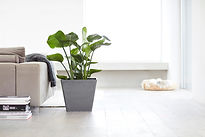
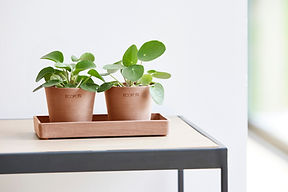
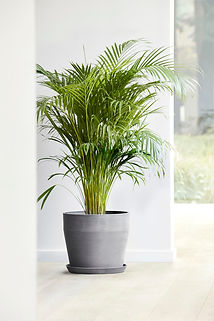
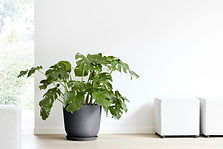
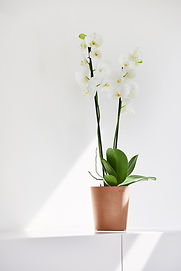
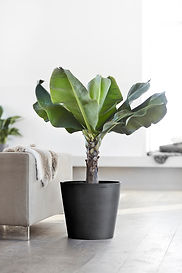
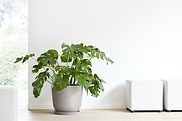
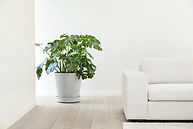
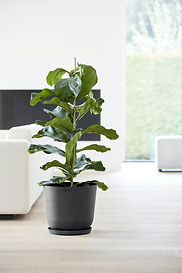
How to maintain your plants & Ecopots
Simple tips to keep your indoor plants thriving and your Ecopots in perfect condition."
Caring for your indoor plants and Ecopots is easy with a few simple practices. From regular plant care to cleaning and maintaining your pots, these tips will ensure a vibrant indoor space and keep your Ecopots as stylish and durable as the day you got them. For added peace of mind, all Ecopots come with our 10-year warranty, offering worry-free indoor gardening year after year.
Regular plant care
Indoor plants require consistent attention to stay healthy and beautiful. Following a routine helps your plants thrive in their Ecopots, even in changing indoor conditions.
Keep in mind:
-
Watering: Check the soil regularly and water only when the top layer feels dry. Use a saucer to monitor excess water.
-
Light adjustment: Rotate your pots every couple of weeks to ensure even growth and exposure to light.
-
Fertilizing: Feed your plants every 4–6 weeks with a plant-specific fertilizer to boost growth.
Cleaning your Ecopots
Daily use and exposure to household dust can affect the appearance of your Ecopots. Regular cleaning keeps them looking fresh and stylish.
Here’s how to care for them:
-
Wipe the surface with a damp cloth to remove dirt and dust.
-
For tougher marks or light scratches, use our Ecopots Cleaning and Repair Kit, which includes a cleaning spray and a sanding pad for light restoration.
-
Rinse with clean water and allow to dry naturally.
This quick routine keeps your pots looking as good as new, adding to your indoor space’s aesthetic appeal.
Repairing scratches or heavy stains
If your Ecopots develop scratches or stains, the Ecopots Repair Sponge is designed to restore their original finish without damage.
How to use:
-
Wet the sponge lightly and gently scrub the affected area.
-
Buff the surface with a dry cloth to bring back the pot’s smooth texture.
Proper care not only maintains your Ecopots’ appearance but ensures their long-term durability. With our 10-year warranty, you can enjoy your indoor garden worry-free. Learn more here.
Are you a plant lover?
Want to be the first to discover innovative plant solutions like PlantX—the soil that keeps your plants thriving with minimal watering, so you can enjoy your holidays stress-free?
Subscribe to our newsletter for exclusive tips, updates, and early access to products that make plant care a breeze.
-
Are Ecopots for indoor or outdoor use?Both! Our larger pots come with a plug in the bottom for drainage, so if you are planning to use one of those pots indoors, we recommend using it with a saucer. Apart from that, you can use Ecopots everywhere you want!
-
What is different between Water reservoir and indoor water system?Ecopots with water reservoir is for both indoor and outdoor use. They are designed with a reservoir at the bottom of the pot which is separated by a disk with holes that prevents the roots of the plants from stagnating in excess water. The roots will get the amount of water they need through capillary force. Ecopots Indoor water system as the product name suggests, is for indoor use. With this system, the plug should not be removed unless in combination with a saucer. The plant gets its water through the wick which absorbs water from the spout. Note that both systems can not be combined.
-
Do all Ecopots have a rubber plug in the bottom?Yes, except for the mini Ecopots, most Ecopots come with plugs., so you can use them for both indoors and outdoors. We advice to remove the plug for both indoor use (with a saucer) and outdoor use to enable excess water to drain. By outdoor use the rubber plug should always be removed in winter to prevent damage by frost.
-
Where can I buy Ecopots?Ecopots are being sold world-wide in a wide range of countries. Many of the stores where Ecopots are being sold can be found on our store locator, but unfortunately not all. Also, more and more online stores, including our own online store, are selling Ecopots, so this may also be a good option. Can’t find a (online or physical) store near you? Drop us a message and we’ll see if we can help you!
-
How do I best pot a plant?Potting a plant has never been so easy! No nasty rims to scratch your hands or to make a mess out of this seemingly simple task (you know what we mean, potting soil all over the place…). However, before you start pouring the potting soil in, make sure you add a granulate (this can also be shards of for instance terra cotta pots) or hydro drains in the bottom (say approx. 1/3 of the pot). Oh, and if you’re planning on using the pot outdoors, don’t forget to remove the plug fist! When the granulate is in place pour in some potting soil, then place our plant, top it off with potting soil and firmly press. Add water and some sweet words to the plant and you’re done. Using the flower pot indoors? Don’t forget to use a saucer when your pot has a rubber plug in the bottom.
-
What are Ecopots made from?Ecopots are made from recycled plastics. Single use plastic is more and more getting a global problem polluting the world’s oceans. One way to deal with this is to find a good way of reusing those plastics, as we do with our pots (we use up to 80% of recycled plastics for our pots). But even more important; we all have the responsibility to prevent plastics turning into waste all together. That’s why Ecopots are timeless in design and colours (you won’t find trendy and funky colours and shapes with us) and have a life span of over 10 years. Because we believe the most durable products are those you don’t want to have to replace every year or so down to breakage or changing trends.
-
Are Ecopots recyclable?Of course they are! Did you know Ecopots are actually made from recycled plastics (up to 80%, the highest percentage in market today)? But you don’t have to think at recycling Ecopots just yet, with a lifespan of over 10 years they will last and last. But, rest assure, when they finally reach the end of their life cycle, they can be fully recycled.
-
Where are Ecopots produced?Our flower pots and planters are being made in Asia, where we have our own production facilities. The main reason for this is that all Ecopots feature a distinctive, handmade finish which would be impossible to do cost effective when produced in for instance Europe or the USA.
-
Why are Ecopots more expensive than other plastic flower pots?There are a lot of plastic flower pots and planters available in market today and even some of them are also using recycled plastics. However, no other pots use the same amount and quality of recycled plastics as we do and also all Ecopots feature a distinctive, handmade finish which gives the pots a unique look and feel. Our flower pots and planters are the closest to pots made from concrete or natural stone, but with all the advantages of plastics flower pots like durability, lightness and frost resistance. Ecopots simply put is a quality product with a sustainable edge and in no way it can’t be compared with cheap plastic pots which flood many markets today.
-
What is the normal response time on my question?If you send your question to support@ecopots.eu we will usually respond as soon as possible, but at maximum within 48 hours (weekdays).
-
How do I prepare/ use my Ecopots Venice?Using your Venice is very simple! First you remove the screw so that the pot itself can be removed from the saucer. Then you add your potting soil to the pot, press it very well and water it in the saucer/ bottom part. The plant will suck the water it needs. You can also place the Venice outside, it will work as perfectly, just check every now and then to see if there is still water in the saucer, that's it!
-
Are Ecopots food-safe for growing fruits and herbs?Yes, Ecopots are safe for growing fruits and herbs. Ecopots are made of recycled materials, and they are free of harmful substances that can leak into the soil and affect plant growth or human health. Ecopots are specially designed for use in horticulture and have been extensively tested to ensure their safety and durability. They are lightweight, UV-resistant and have a natural look that blends seamlessly into any garden or home environment.
-
Are Ecopots 100% waterproof?Most of them are, but not all. Some flower pots and planters have a rubber plug in the bottom of the pot and, although it has a tight fit, it could leak some water. So we advise to always use a saucer when your flower pot has a rubber plug.
-
Do I need a saucer with my Ecopots?When you have an Ecopots with a rubber plug in the bottom and you’re planning on using your flower pot for indoor use, we advise using a saucer with your flower pot. Although our pots are close to 100% leakproof, we can’t guarantee that absolutely no water will sip through and potentially mess up your lovely carpet or authentic wooden floor. So, for indoor use it’s best to use a saucer.
-
Can I remove the plug in the bottom?Yes you can! Pots from our 2018 or earlier collection can be removed like described below. Pots from our 2019 and up collection have a screw plug which can be removed with a simple twist. You can tell from what collection your pot is by looking at the barcode: the last four digits represent month and year of production (so 0618 is June 2018). We advice to remove the plug for both indoor use (with a saucer) and outdoor use to enable excess water to drain. By outdoor use the rubber plug should always be removed in winter to prevent damage by frost.
-
How do the plugs in Ecopots work?Plugs in Ecopots refer to the removable plastic or rubber stoppers that can be inserted into the drainage holes in the bottom of the pot. These plugs are useful for controlling the drainage of water from the pot. For outdoor use, it is recommended to remove the plugs from the pots drainage hole to prevent the pot from cracking in case of frost. For indoor use , it is recommended to keep the plug in the drainage hole as the Ecopots stays waterproof and do not let the water flow out of your Ecopots. We always advise to put a saucer under the Ecopots to protect the floor. From time to time you can remove the plug as it also helps to regulate the amount of water that reaches the plant's roots, preventing over-watering and ensuring that the soil remains moist but not waterlogged.
-
Do I need to remove the plug in winter?Yes! In winter, we advice to remove the plug if you want to keep your pots outside. Frost may cause cracks and leaks if not taken out.
-
How do I remove the plug from the bottom?Some of our flower pots and planters have a black rubber plug in the bottom of the pot. This plug can be removed for outside use, so excess water can drain away. To remove this plug, take a blunt object (like a flat screwdriver) and a hammer. Place the pot bottom side up on a solid, flat surface, then place the blunt object onto the plug and give it a good whack with the hammer. The plug fits pretty solid, so don’t be shy, and it should come out. Don’t throw away the plug, you may want to use it again in the future! We advice to remove the plug for both indoor use (with a saucer) and outdoor use to enable excess water to drain. By outdoor use the rubber plug should always be removed in winter to prevent damage by frost.
-
Can my Berlin Growtable or Berlin Tower rust?The Ecopots Berlin Grow Table is made of galvanized steel which has been powder coated to make it more durable and resistant to rust. To prolong the life of the table and prevent rust, it is recommended to keep it dry and clean, and avoid exposing it to prolonged periods of moisture or harsh weather condition for instance high salinity from the sea for people living at the coast. We advise to take the Ecopots Berlin Grow Table and Tower inside during wintertimes
-
Are Ecopots frost resistant?Yes, Ecopots are frost-resistant. They are designed to withstand extreme weather conditions, including freezing temperatures. Ecopots are made from high-quality recycled materials which are durable and able to withstand the effects of frost, without cracking or deteriorating. So there is no worries if the plug is removed during the cold weather, so any excess water at the bottom can flow and won't cause freezing and cracking.
-
Are Ecopots wheels rustproof?Yes, all the wheels we use are made of stainless steel, which makes them resistant to rust and corrosion.

